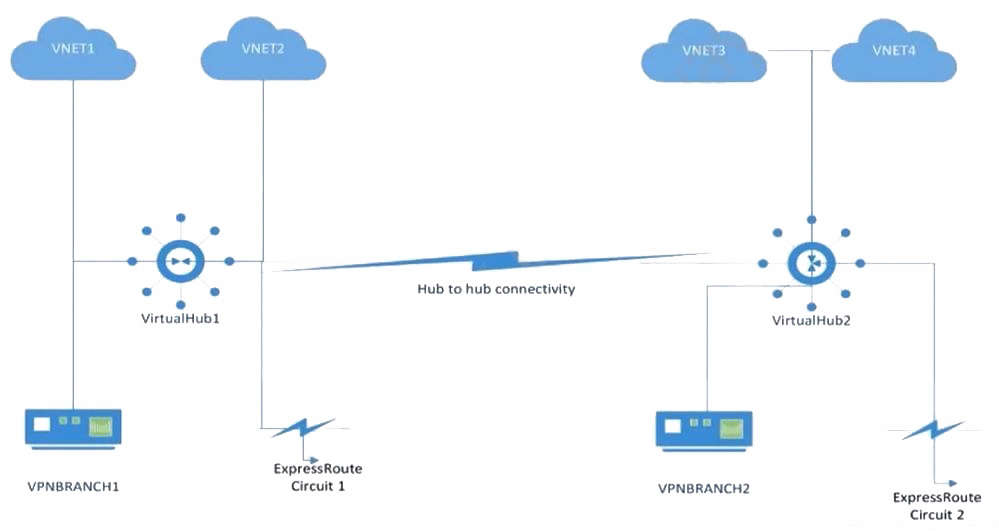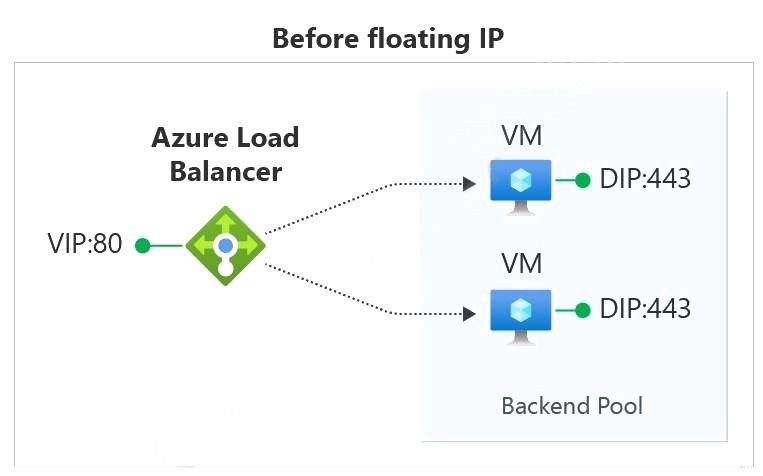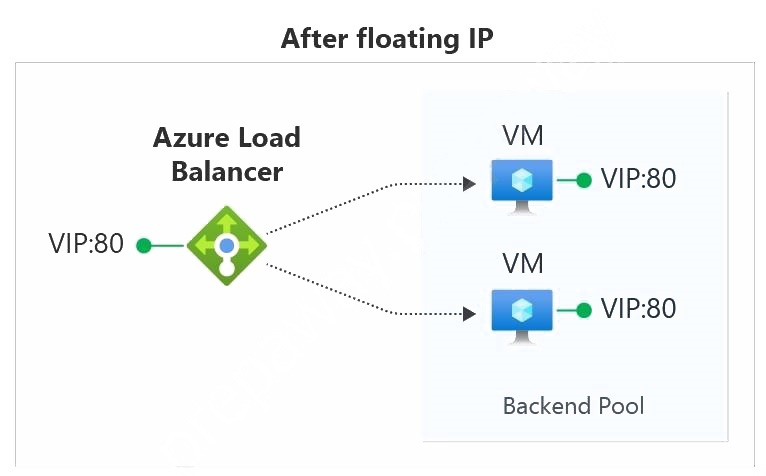Exam Details
Exam Code
:AZ-700Exam Name
:Designing and Implementing Microsoft Azure Networking SolutionsCertification
:Microsoft CertificationsVendor
:MicrosoftTotal Questions
:390 Q&AsLast Updated
:Apr 08, 2025
Microsoft Microsoft Certifications AZ-700 Questions & Answers
-
Question 191:
Your company has four branch offices and an Azure subscription. The subscription contains an Azure VPN gateway named GW1. The branch offices are configured as shown in the following table.

The branch office routers provide internet connectivity and Site-to-Site VPN connections to GW1.
The users in Branch1 report that they can connect to internet resources, but cannot access Azure resources.
You need to ensure that the Branch1 users can connect to the Azure resources. The solution must meet the following requirements:
1.
Minimize downtime for all users.
2.
Minimize administrative effort. What should you do first?
A. Recreate LNG1.
B. Reset RTR1.
C. Reset Connection1.
D. Reset GW1.
-
Question 192:
You have a hub-and-spoke topology. The topology includes multiple on-premises locations that connect to a hub virtual network in Azure via ExpressRoute circuits.
You have an Azure Application Gateway named GW1 that provides a single point of ingress from the internet.
You plan to migrate the hub-and-spoke topology to Azure Virtual WAN.
You need to identify which changes must be applied to the existing topology. The solution must ensure that you maintain a single point of ingress from the internet.
Which three changes should you include in the solution? Each correct answer presents part of the solution.
NOTE: Each correct selection is worth one point.
A. Add user-defined routes.
B. Add virtual network peerings.
C. Replace the user-defined routes used by the current topology.
D. Create virtual network connections.
E. Remove the existing virtual network peerings.
F. Redeploy GW1.
-
Question 193:
Your company has 40 branch offices that are linked by using a Software-Defined Wide Area Network (SD-WAN). The SD-WAN uses BGP.
You have an Azure subscription that contains 20 virtual networks configured as a hub and spoke topology. The topology contains a hub virtual network named Vnet1.
The virtual networks connect to the SD-WAN by using a network virtual appliance (NVA) in Vnet1.
You need to ensure that BGP route advertisements will propagate between the virtual networks and the SD-WAN. The solution must minimize administrative effort.
What should you implement?
A. An Azure VPN Gateway that has BGP enabled
B. a NAT gateway
C. Azure Traffic Manager
D. Azure Route Server
-
Question 194:
You have an Azure subscription that contains the following resources:
1.
A virtual network named Vnet1
2.
Two subnets named subnet1 and AzureFirewallSubnet
3.
A public Azure Firewall named FW1
4.
A route table named RT1 that is associated to Subnet1
5.
A rule routing of 0.0.0.0/0 to FW1 in RT1
After deploying 10 servers that run Windows Server to Subnet1, you discover that none of the virtual machines were activated.
You need to ensure that the virtual machines can be activated.
What should you do?
A. On FW1, create an outbound service tag rule for AzureCloud.
B. Add an internet route to RT1 for the Azure Key Management Service (KMS).
C. On FW1, configure a DNAT rule for port 1688.
D. Deploy an Azure Standard Load Balancer that has an outbound NAT rule.
-
Question 195:
You have an Azure subscription.
You plan to implement Azure Virtual WAN as shown in the following exhibit.

What is the minimum number of route tables that you should create?
A. 1
B. 2
C. 4
D. 6
-
Question 196:
You have an internal Basic Azure Load Balancer named LB1 that has two frontend IP addresses. The backend pool of LB1 contains two Azure virtual machines named VM1 and VM2. You need to configure the rules on LB1 as shown in the following table.

What should you do for each rule?
A. Enable Floating IP.
B. Disable Floating IP.
C. Set Session persistence to Enabled.
D. Set Session persistence to Disabled.
-
Question 197:
You need to use Traffic Analytics to monitor the usage of applications deployed to Azure virtual machines. Which Azure Network Watcher feature should you implement first?
A. Connection monitor
B. Packet capture
C. NSG flow logs
D. IP flow verify
-
Question 198:
You have an Azure virtual machine named VM1.
You need to capture all the network traffic of VM1 by using Azure Network Watcher.
To which locations can the capture be written?
A. blob storage only
B. blob storage, a file path on VM1, and a premium storage account
C. a file path on VM1 only
D. blob storage and a file path on VM1 only
E. blob storage and a premium storage account only
F. a premium storage account only
-
Question 199:
You have the Azure virtual networks shown in the following table.

You have the Azure resources shown in the following table.

You need to check latency between the resources by using connection monitors in Azure Network Watcher.
What is the minimum number of connection monitors that you must create?
A. 1
B. 2
C. 3
D. 4
E. 5
-
Question 200:
You have a network security group named NSG1.
You need to enable network security group (NS) flow logs for NSG1. The solution must support retention policies.
What should you create first?
A. A standard general-purpose v2 Azure Storage account
B. An Azure Log Analytics workspace
C. A standard general-purpose v1 Azure Storage account
D. A premium Block blobs Azure Storage account
Related Exams:
62-193
Technology Literacy for Educators70-243
Administering and Deploying System Center 2012 Configuration Manager70-355
Universal Windows Platform – App Data, Services, and Coding Patterns77-420
Excel 201377-427
Excel 2013 Expert Part One77-725
Word 2016 Core Document Creation, Collaboration and Communication77-726
Word 2016 Expert Creating Documents for Effective Communication77-727
Excel 2016 Core Data Analysis, Manipulation, and Presentation77-728
Excel 2016 Expert: Interpreting Data for Insights77-731
Outlook 2016 Core Communication, Collaboration and Email Skills
Tips on How to Prepare for the Exams
Nowadays, the certification exams become more and more important and required by more and more enterprises when applying for a job. But how to prepare for the exam effectively? How to prepare for the exam in a short time with less efforts? How to get a ideal result and how to find the most reliable resources? Here on Vcedump.com, you will find all the answers. Vcedump.com provide not only Microsoft exam questions, answers and explanations but also complete assistance on your exam preparation and certification application. If you are confused on your AZ-700 exam preparations and Microsoft certification application, do not hesitate to visit our Vcedump.com to find your solutions here.

